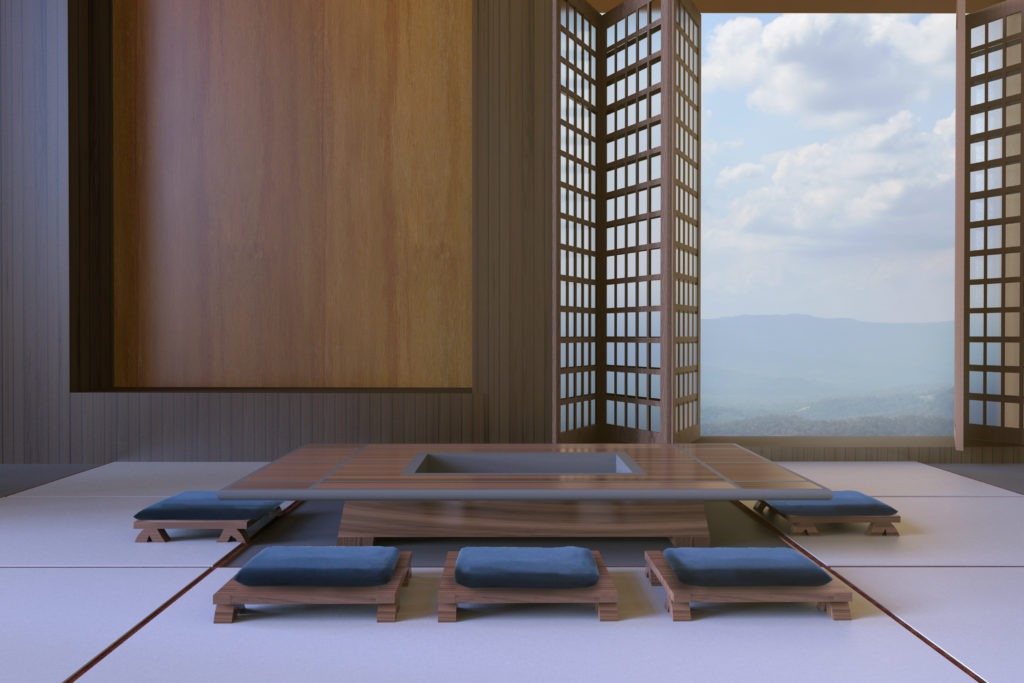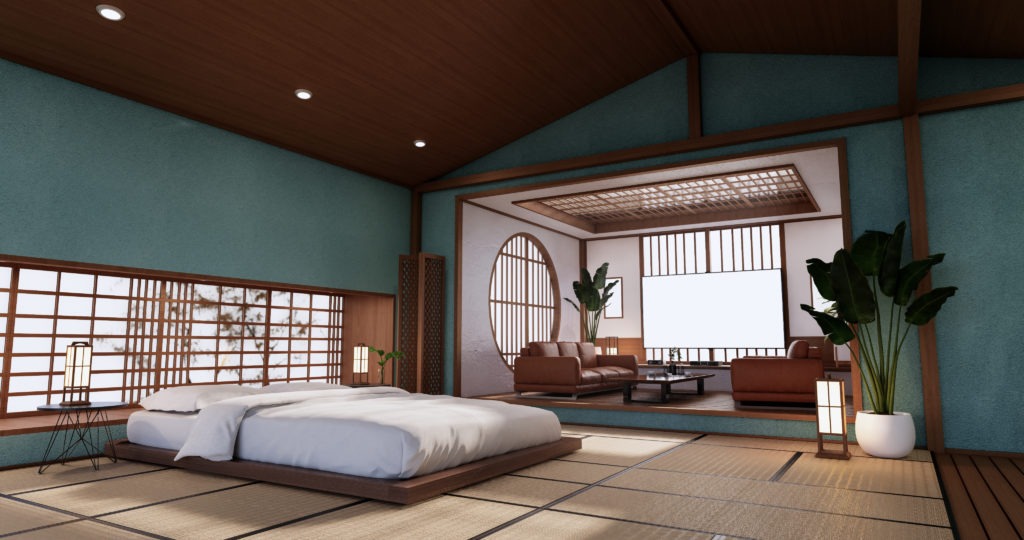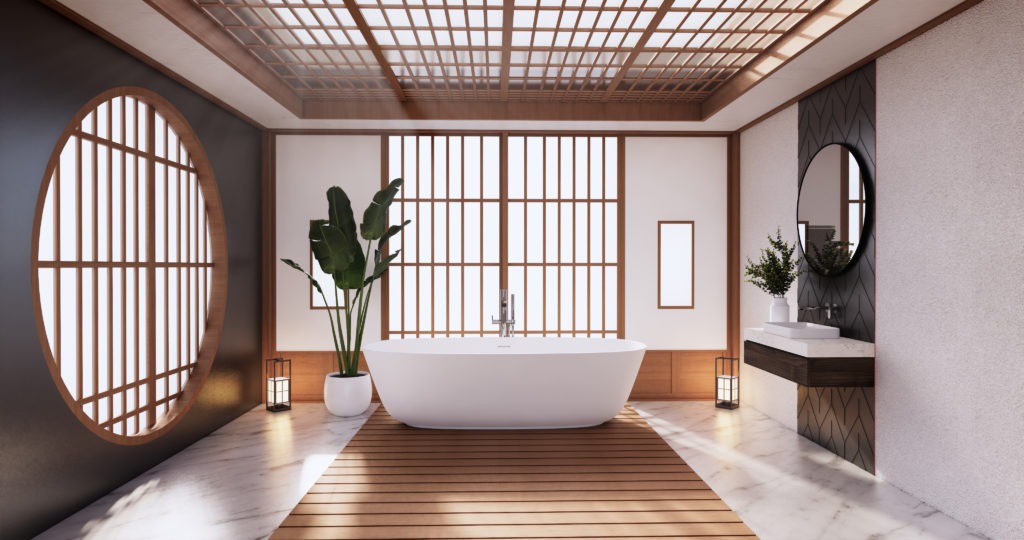The aesthetics and materials of traditional Japanese architecture and interior design are heavily influenced and inspired by nature. Some other great options for a Japanese-inspired interior are tatami mats, Shoji doors and windows, wooden room dividers, and straw and bamboo drapes.
The concept of “Zen” immediately comes to mind when one considers the aesthetics of Japanese home design. This traditional pattern, which has been around for thousands of years and is known as “Kanso,” is not only tranquil but also a cultural reflection of the Japanese way of life. The traditional Japanese interior design style is grounded in tried-and-true principles that we should all adhere to when decorating the inside of our homes.
The Concept of Japanese Interior Designs
1. Use Open Spaces
Even the smallest Japanese home feels spacious because of the Japanese emphasis on minimalism and efficiency. The use of “Ma” helps to establish this value. Japanese interior designers follow this aesthetic and art of living by arranging furniture and other components of space so that they flow into one another. Everything is precisely where it should be and serves some greater purpose. Only one or two walls in a room are lined with furnishings, leaving the remainder of the room open and uncluttered.
Simple furniture arrangement along two or three walls is all it takes to get this outstanding design style in any area. Choose floor-standing furniture with a basic design aesthetic. Choose a huge cabinet, a chest of drawers, or a built-in table with storage space. These furniture pieces are perfect for storing necessities and preventing clutter. Wall hangings are another option for sprucing up the space.
2. Think About Using Wallpaper with Some Japanese Influence
Floor mats or a sizable area rug with a design that goes with the rice paper can be set up in the living room. Place a huge coffee table in the center of the room and furnish it with some dark, sleek hardwood furniture. Keep things simple and open plan in the same way that the Japanese do.
3. Enhance your aesthetic by using elements from nature.
The Japanese have a knack for fusing traditional methods with cutting-edge design. Natural components are a great way to incorporate the minimalist and form-focused design style into your home. Incorporate enough natural light into your design plans using skylights, oversized windows, and glass doors. Next, furnish the space with natural wood furniture in a simple style and some natural wallpapers, such as grass rugs or straw mats.
Bonsai trees, ferns, and other indoor plants are all viable options. Ikebana, the Japanese art of flower arranging, can also be used to inject some much-needed vibrancy into the interior design scheme. Experiment with earthy color palettes like beige, brown, and shades of blue and green to bring the outside in. Make as much use of plants as possible without disrupting the flow of the open floor layout. The incorporation of these Zen-like natural elements into the home is a must.
4. Use simple patterns and white colors for minimalist designs.
White is the color most indicative of Japanese aesthetics. Its literal meaning is to communicate the principles of Zen philosophy and the aesthetic of minimalism. Cabinets, cupboards, hinged doors, and walls should all be designed using white and various colors. The glass windows and skylights provide additional opportunities to bring in natural light. The predominantly white color scheme gives the impression of spaciousness and lightness. It’s a great way to unwind the brain. With minimal effort, this color palette brings the Zen and minimalism of Japanese culture into the home.
5. Use Sliding Doors, Screens, and Dividers
Sliding doors and windows is another way the Japanese conserve space in their otherwise spare rooms. The concept was first implemented so that swinging door panels wouldn’t have to be placed out of the way of other pieces of furniture. Shoji was initially incorporated to maximize the utilization of natural light while minimizing the use of interior space. Sliding glass doors are now commonly used in this context, marking a change in tradition through time. This method is not limited to doors; windows also benefit from it, allowing the Japanese home to look sleek and contemporary while making better use of available square footage.
Walk-in and standard closets alike can benefit from sliding doors. Space dividers are also a significant inspiration for Japanese interior design. You may split a large room in two by installing these Shoji screens. If you have a large living room, you can divide it with sliding walls to make a dining area or a play space for the kids. The white screens and dividers are particularly effective in giving the impression of a wall. This is an excellent example of incorporating minimalism into your design to evoke Japanese sensibilities.
6. Wooden objects and straws should be incorporated.
Natural materials are highly encouraged for usage in the interior design of a Japanese home, as the aesthetic of Japanese architecture and interior design is centered on the natural world. Use straw and bamboo blinds, Shoji-style sliding doors and windows, wooden room dividers, and Tatami mats to create a relaxing and calming atmosphere. Natural wood furniture is a timeless investment that can be used in a classic or contemporary setting. They give the space a more refined and organic air.
7. Make entrances in the Genkan style.
A tiny passageway leading to the living area can be designed in the style of the Genkan gateways. Creating it on a raised platform separates it from the rest of the foyer. In a typical Japanese home, shoes are left at the door. That being the case, the Genkan is also an appropriate place for shoe racks. For a Japanese aesthetic, place some area rugs or mats in neutral colors beside the front door—Accent the space with Tatami mats or Japanese-style plants. You don’t need to put up a platform if you use some big doormats to cover the ground around the doorways. Put in some plants beside the door and around the walls to make it look like there’s a porch.
8. The Extra-Large Bathtubs Are a Must-Have
To achieve a Japanese aesthetic, you need not resort to an authentic wooden tub. Nowadays, marble and ceramics are also used in contemporary designs for Ofuro. Adding a deep tub to the bathroom is a simple way to combine traditional Japanese aesthetics into a more modern Western setting. It’s designed to look like a luxurious spa where you can bathe for hours. You can get away with a deeper tub if your bathroom isn’t big enough for a standard soaker. Make sure the rest of the bathroom is neat and uncluttered.
9. Use low-bearing furniture to design
Japanese people are more comfortable sitting on the floor than in conventional seats. When sitting, it helps them keep their back straight. Low tables and chairs are a great way to incorporate this style into your Japanese-inspired home decor. Prepare a floor seating area by placing a large coffee table in the center. Low-height TV stands and entertainment centers can also be used. Adapting the aesthetics of traditional Japanese interior design to a more contemporary space requires the use of height-adjustable furniture. This will allow you to place couches and other forms of seating. For a more authentic Japanese experience, it is easy to lower the table and have visitors sit on cushions on the floor in the traditional manner.
10. Keep It Simple and Clean
When attempting to incorporate Japanese interior design elements into your design style, simplicity is of utmost importance. The wabi-sabi aesthetic encourages a focus on simplicity and the cultivation of tranquility. There is no requirement for perfection, but everything should serve a proper function. Blending elements of Japanese and Scandinavian interior design is possible. They share the idea that less is more and that a home’s structure and design should reflect that. Craftsmanship is the key to blending the traditional Japanese aesthetic with the cutting edge of today’s residential design trends. Align contemporary pieces with classic Japanese Shoji or Genkan doors for a stunning effect.
CONCLUSION
People used to believe that having the most outlandish furniture made them appear wealthy. However, as time progressed, when contemporary men learned the essence of true elegance, they started embracing minimalism. They gradually incorporated this idea into their home to express Zen-related feelings. Ancient traditions are revered and passed down in Japan, along with Zen and minimalist ideals and a focus on living in harmony with nature. They stay true to form by liberally using plants in their plans. Natural light and open areas are also abundant. The aesthetics of Japanese homes have hardly changed in a millennium. The emphasis is on simplicity and utility. We might consider them cutting-edge concepts, yet the Japanese have based their whole society on them.



